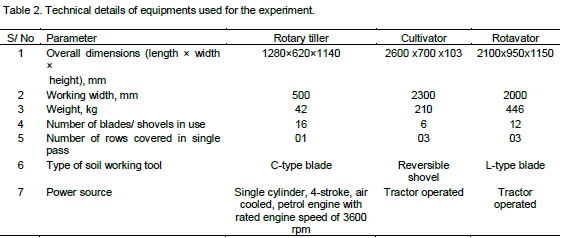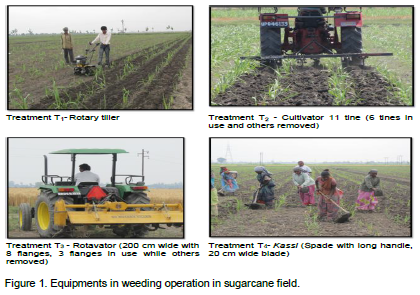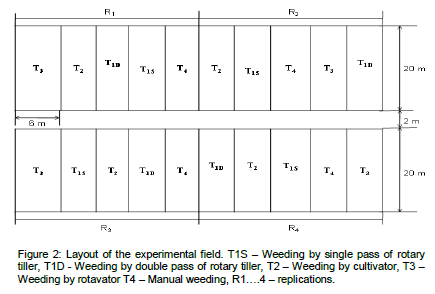ABSTRACT
Manual weeding/ interculture in sugarcane is a common method adopted by the farmers, in Tarai region of Uttarakhand, for weed control. However, due to non- availability of labour especially during peak season, the weeding/interculture operation is jeopardized. Also the labour demand in sugarcane weeding is very high compared to other cereal crops making this operation expensive. This study includes comparative performance evaluation of three different types of equipment, namely rotary tiller (T1S -single pass and T1D - two pass of rotary tiller), cultivator (T2) and rotavator (T3) for weeding operation in sugarcane. It was also compared with manual method of weed control (T4) including the cost economics. The result revealed that among the mechanical methods, the highest weeding efficiency (93.20%) was obtained in T1D followed by T1S (88.01%), T3 (87.97%) and T2 (83.22%). The plant damage was observed highest (3.67%) in T2 compared to T3 (2.63%), T1D (1.83) and T1S (1.11%). Cost of weeding operation was found minimum (INR 374.37 per ha) for treatment T2 followed by T3 (INR 507.27 per ha), T1 (INR 1186.18 per ha) and T4 (INR 13194.55 per ha). The reduction in cost of weeding over the conventional method was found highest (97.16%) in T2 followed by T3 (96.16%) and T1 (91.01%). The use of rotary tiller can be recommended to the farmer for weed management in sugarcane even at later stage of the crop when plant is tall enough making use of other equipment unfeasible.
Key words: Rotary tiller, intra-row weeder, cultivator, rotavator, manual weeding, mechanical weeding, sugarcane, economics.
Sugarcane, Saccharum officinarum L., is grown under diverse agro-climatic conditions around the world. It is a renewable and natural agricultural resource that provides sugar, besides biofuel, fibre and fertilizer. Out of the total white crystal sugar production, approximately 70% comes from sugarcane and 30% from sugar beet. According to FAO, 2011 report, worldwide sugarcane occupies an area of 25.44 million ha with a total production of 1794 million metric tons. Out of 121 sugarcane producing countries, Brazil, India, China, Thailand, Pakistan, Mexico, Cuba, Columbia, Australia, USA, Philippines,
South Africa, Argentina, Myanmar and Bangladesh collectively represent 86% of the area and 87% of production. Brazil has the highest area (9.601 million ha), while Australia has the highest productivity (81.7 tons/ha).
India, the second largest sugarcane producing country after Brazil, cultivated sugarcane in 5.09 million ha area, which is much less compared to area under cereals, pulses and oilseeds, with a production of 357.67 Million Tones in the year 2011 to 2012. Sugarcane is grown mainly in the states of Maharashtra, Karnataka, Gujarat, Tamil Nadu, Uttar Pradesh, Punjab, Haryana and Bihar. Among these, Uttar Pradesh alone occupies about 43% of the total area under sugarcane cultivation dominating in production but in terms of productivity, Tamil Nadu leads with 104 tons/ha followed by Karnataka (90 tons/ha) and Maharashtra (83 tons/ha) which is higher than the national average productivity of 68.6 tons/ha. In the state of Uttarakhand it is grown mainly in its Tarai region (foot hills) where its production has gone down to 5.05 million tonnes in year 2010 compared to 7.34 million tonnes in year 2001. Highest sugarcane production of 7.68 million tonnes was registered during the year 2008.
It has been observed that the productivity of sugarcane, national average, is stagnating around 65-70 tons/ha for the last about 2 decades. Non implementation of package of practices and shortage of agricultural labour to undertake various cultural practices in time including poor weed management are some of the reasons responsible for low sugarcane yield. Therefore, there is a need to focus on other means including proper weed management for improving the production and productivity. It is reported that the yield loss caused by weeds may range from 15 to 75% depending upon its nature and intensity (Olaoye and Adekanye, 2006; Hasanuzzaman et al., 2009). The initial 90 to 120 days period of crop growth is considered as most critical period of weed competition and therefore weed-free field condition during these days must be ensured for higher yield.
Manual weeding, which is a common practice including in Tarai region of Uttarakhand, provides almost a clean weed free field but is highly labour demanding operation. The labour requirement for weeding/ interculture operation alone ranges between 400 to 600 man-h/ha (Tajuddin, 1996; Singh and Panghal, 2012) which is the highest when compared to wheat and rice (Table 1). Also it is a slow, arduous and time consuming process leading to higher cost of production. Scarcity of agricultural labourers during the peak season makes this task more difficult. Because of this reason as well as concern over environmental degradation and a growing demand for organically produced food, mechanical method of weed control is gaining popularity over manual and chemical methods. It is very effective, eliminates drudgery involved in manual weeding, kills the weeds and also keeps the soil surface loose ensuring better soil aeration and water intake capacity. Most of the tractors owning farmers, in Tarai region of Uttarakhand state, are using cultivator and rotavator, by manipulating the tynes/blades spacing, to cope up with the shortage of labour for weeding operation in sugarcane. Also there has been an increasing interest in the use of rotary tillers (mechanical intra-row weeders) due to their availability in the area during the recent years for weeding operation in sugarcane crop. However, systematic data is not available in respect of these equipment for weeding operation in sugarcane. The present study was, therefore, undertaken to compare the field performance of a rotary tiller, cultivator and rotavator for weeding operation in sugarcane crop along with traditional method including their economics.

Description of equipment used
Three types of equipment namely self propelled rotary tiller (3.5 kW petrol engine operated), tractor drawn cultivator and rotavator were used for this study. The rotary tiller has a working width of 50 cm and only one row was covered during its operation. The second equipment was a tractor mounted type spring loaded 11 tine cultivator with overall width of 230 cm. Out of 11 tines, 5 tines were removed to adjust the cultivator within the row spacing of sugarcane. Three rows of sugarcane were covered at a time during single pass of this implement. The third equipment was a tractor mounted type rotavator having a work width of 200 cm. It had 8 flanges arranged on a rotor shaft with four L-shaped blades on each flange. Out of 8 flanges, 5 flanges were removed to adjust the rotavator to operate in between the rows of sugarcane. Three rows of sugarcane were covered at a time during single pass of this rotavator. Table 2 shows the technical details of the equipment used for the experiment. Manual method of weeding, a very common practice, was used as control for this experiment. The common tool used for manual weeding is Kassi which is a long handled spade with 20 cm wide blade. It is commonly used in upright posture by the labourers. Figure 1 shows the different equipment in weeding operation.


Experimental field
The performance evaluation of all the three mechanical equipment as well as manual weeding was carried out on University Farm (T-block, Eastern Zone Beni) of G. B. Pant University of Agriculture and Technology, Pantnagar, India during the month of April. The sugarcane crop was planted at a row space of 75 cm. The soil of experimental field is of alluvial origin and classified as silty-clay-loam having 15.1, 55.2 and 29.7% of sand, silt and clay respectively. The weeding operation was performed after 80 days of planting of sugarcane crop. The main field was divided into 20 sub plots each of size 20 × 6 m. Figure 2 shows the layout of the experimental field.

Experimental parameters
The experiment was laid out in Completely Randomized Design (CRD) with five treatments (T1S -single pass of rotary tiller; T1D - two passes of rotary tiller; T2 -weeding by cultivator; T3 -weeding by rotavator and T4 - manual weeding) and four replications of each treatment.
Performance indicators
Weeding efficiency, plant damage and field capacity was taken as performance indicators. Besides these field efficiency, fuel consumption, size of soil aggregate, bulk density and cost of operation were also determined. Weeding efficiency and plant damage were determined as per the standard procedure (RNAM, 1983) using the following equations:
Where, W1 and W2 are the weight of weeds, in grams, before and after weeding operation respectively. Q1 and Q2 are the number of plants in 10 m row length before and after tilling operation respectively.
Effective field capacity (Fc), field efficiency (Fe) and work capacity (Wc) were calculated by the following equations (Hunt, 1995).
Where, Fc is the effective field capacity (ha/h ), S is the speed of operation (km/h), W is the effective width of coverage per run (m), E is the field efficiency (%) of equipment, Te and Tt are the effective and total working time (h) and Wc is the working capacity (h/ha), respectively.
Cost analysis was performed by determining the fixed and variable cost for all the equipment. Straight line method was used for determining the depreciation cost. Salvage value has been assumed as 10% of the purchase price. Insurance, taxes and shelter has been assumed negligible for the equipment and the same has been taken as 3% for tractor. Rate of interest has been assumed as 10% per annum. Fuel charge has been determined based on actual fuel consumed and its prevailing rate in the market. Lubrication charge has been assumed as 30% of the fuel charge. Repair and maintenance has been assumed as 6% of purchase price per annum. Labour charge has been considered as per the prevailing rate per day (8 h work). Annual operation of the equipment has been considered as 720 h based on maximum 90 days (daily 8 h) of actual use in sugarcane weeding. The following equation was used to determine the cost of operation as suggested by Hunt (1995).

Where, C = Cost of operation, INR/h, Fc = Fixed cost, INR/h which includes depreciation, interest on capital, insurance-taxes and shelter cost, RM = Repair and maintenance costs, INR/h, F = Fuel cost, INR/h, O = Lubrication cost, INR/h, L = Labour cost, INR/h (assumed as INR 190/day).
Statistical method
The data collected during the experiment was analyzed for its significance using Completely Randomized Design (CRD).
Weeding efficiency
The weeding efficiency was determined by considering the weight of weeds before and after weeding operation. The weeding efficiency for single pass and double pass of rotary tiller was found highest followed by treatment T3 and T2 (Table 3). Weeding efficiency for double pass of rotary tiller was found higher by 5% than its single pass. The higher soil cutting ability of rotary tiller and rotavator contributed to higher weeding efficiency where as the reversible shovel does not provide better soil cutting leading to lower weeding efficiency. Weeding efficiency of manual weeding method (T4) was observed highest among all the treatments which may be due to the fact that more precisely intra row area could be covered in manual method of weeding. Statistical analysis (Table 4) indicated that the weeding efficiency for different weeding methods varied significantly at 5% level of significance except treatments T1S and T3.
Plant damage
The plant damage for single pass and double pass of rotary tiller was found 1.11 and 1.83% (Table 3). The plant damage for treatment T1D (double pass of rotary tiller) was found to increase by about 0.72% compared to treatment T1S (single pass of rotary tiller). This may be due to the increase in depth of operation causing more uprooting of the plants. The plant damage, on an average, for other weeding methods viz manual weeding, rotavator and cultivator was found 0.56, 2.63 and 3.67% respectively. The lowest plant damage was observed in case of manual weeding that may be because of shallow depth of operation and care taken during the weeding operation. Among the mechanical methods of weeding, single pass of rotary tiller showed minimum plant damage. The plant damage was found statistically significant for all the weeding methods (Table 4).
Field capacity and field efficiency
Actual field capacity for different weeding methods was determined which showed higher field capacity for treatment T2 followed by treatments T3 and T1 (Table 3). The higher field capacity for treatment T2 was due to more width of operation of cultivator. The field capacity of rotary tiller in double pass (T1D) was found 35% higher when compared with its single pass which may be due to higher speed of operation. The field capacity for different weeding methods was found statistically significant (Table 4). The field efficiency (Table 3) for single pass of rotary tiller was found to vary in between 96.69 to 97.18% with an average of 96.93% which was found slightly less (94.1%) for double pass of the tiller. The average field efficiency of weeding by rotavator and cultivator was 87.08 and 80.92% respectively.
Fuel consumption
The fuel consumption for single pass of rotary tiller (T1S) was found 0.58 l/h and little less, 0.53 l/h, for its double pass operation (T1D). The fuel consumption for other treatment T2 and T3 (weeding by cultivator and rotavator) was found as 3.19 and 2.87 l/h respectively (Table 5). The statistical result indicated that the fuel consumption for different weeding methods varied significantly at 5% level of significance (Table 4).
Clod size and bulk density
The clod mean weight diameter for single and double pass of rotary tiller was found as 7.67 mm and 4.01 mm respectively (Table 5). The reduction in clod size, in case of double pass, was about 47.7% which may be due to similarly clod size in treatment T2 and T4 was also comparable. However, statistical analysis showed that clod size varied significantly, at 5%, for all the weeding methods (Table 4).
The average bulk density (Table 5) for treatment T1S and T1D was found as 1.27 and 1.26 g/cc. The reduction in bulk density values, in rotary tiller, was observed nearly same. The average bulk density for treatments T2, T3 and T4 was found as 1.29, 1.23 and 1.24 g/cc respectively. The decrease in bulk density was observed higher (8.05%) in case of treatment T3 and the same was observed less (3.88%) in case of weeding by cultivator (T2) when compared with other treatments. The bulk density value for treatment T2 was found significantly higher than other treatments. The change in bulk density values for all other treatments except T2 was found insignificant (Table 4).
Moisture content
Soil moisture content was determined for each test plot and the results have been presented in Table 5. The average initial soil moisture content of the experimental plots was observed as 16.68%. The final soil moisture content was observed to reduce for all the treatments as compared to initial value, however, the moisture loss was observed more in treatments T1D and T4 followed by T2, T3 and T1S. In treatments T2 and T4 the moisture loss was observed to be almost similar that may be due to bigger size of clods providing more surface area for moisture evaporation.
Cost analysis
Cost of weeding operation for different treatments was determined using the data presented in Table 6. The detailed analysis is presented in Table 7 which showed least expenditure (INR 374.37 per ha) for treatment T2 followed by T3 (INR 507.27 per ha), T1 (INR 1186.18 per ha). Highest expenditure of INR 13194.55 per ha was found incase of T4 that is, manual method of weeding. The minimum cost of weeding in T2 is due to the higher field capacity of cultivator as compared to weeding by other methods. Manual weeding was found to be expensive which is due to very less field coverage per unit of time. Similarly the cost reduction over the conventional method was found highest (97.16%) in T2 followed by T3 (96.16%) and T1 (91.01%).
Among the mechanical methods, treatment T1D and T1S (weeding by rotary tiller - one and two pass) was found more effective compared to treatments T2 (weeding by cultivator) and T3 (weeding by rotavator) based on higher weeding efficiency and minimum plant damage. Treatment T1S and T3 was found equally effective as far as weeding efficiency is concern. The cost of weeding, when compared with conventional method, reduced in T2, T3 and T1 by 97.16, 96.16 and 91.01% respectively. The conventional method of weeding was found expensive compared to mechanical methods. The use of rotary tiller, among the mechanical methods, can be recommended to the farmers for efficient weed management even though the cost of operation is high. The advantage is that as it covers single row of the crop it can be used even at a later stage when plant grows tall enough. The use of cultivator and rotavator is not feasible at later stage (beyond 120 days of crop) as it covers more than one row and the plant will get damage when the height of the plant is more than the toolbar height.
The authors have not declared any conflict of interest.
REFERENCES
|
Hasanuzzaman M, Ali MH, Alam MM, Akhtar M, Fakhrul, Alam K (2009). Evaluation of pre-emergence herbicide and hand weeding on the weed control efficiency and performance of transplanted rice. American-Eurasian J. Agron. 2(3):138-143. |
|
|
|
Hunt D (1995). Farm power and machinery management (9th Edn.). Iowa State University Press. Ames, IA, USA. |
|
|
|
Olaoye JO, Adekanye TA (2006). Development and evaluation of a rotary power Weeder. Proc. Nig. Soc. Agric. Eng. 3:189-199. |
|
|
|
RNAM (1983). RNAM test codes and procedures for farm machinery. Technical series Regional Network for Agricultural Machinery (RNAM), Bangkok, Thailand.12:133-149. |
|
|
|
Singh RP, Panghal SS (2012). Mechanization of sugarcane agriculture-a solution for low sugar availability in website www.scribd.com |
|
|
|
Tajuddin A (1996). Advances in mechanical method of weed control. Paper presented in Short Courses on Advances in Weed Management Agro Ecological Context, June,10-19,1996. Center of Advanced Studies in Agronomy, TNAU, Coimbatore. |
|